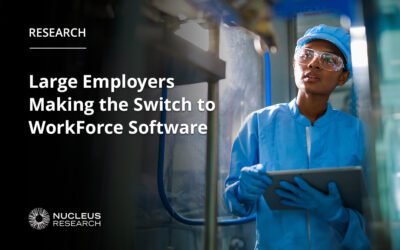The Benefits of Delivering a Great ‘EX’ to Deskless Workers


Steve Goldberg
HCM Industry Analyst, Advisor, Influencer
As widely chronicled by SHRM in recent years, the Covid era often saw between 500,000 and one million U.S. workers voluntarily exit their jobs in a particular month. These startling numbers were sourced from the U.S. Bureau of Labor Statistics, and in the case of this cited article, covered two industry sectors of predominantly deskless or hourly paid (overtime pay-eligible) employees. The restaurant and hospitality verticals were the ones highlighted in this research. It’s perhaps safe to assume that a percentage of these workers quit because they were asked to work harder or on less attractive shifts to cover for others not at work. Another subset of the group, those whose income level was very dependent on gratuities, probably sought out new ways of achieving previous income levels.
Naturally when workers don’t show up or quit altogether, a cascading set of negative consequences can occur, some of which (viewed in isolation or grouped with others) can be hard or even impossible for a typical business to recover from. In customer-facing industries such as the two mentioned above (or the likes of retail, transportation, or healthcare) the reputation of an enterprise or brand can quickly plummet, along with its flow of customers and associated revenue. In other sectors such as manufacturing, business continuity issues and the inability to meet contracted production targets can hasten a decline even faster.
But let’s move on to the present day, where the effects of the pandemic might be in the rear-view mirror for many fortunate businesses even while individuals in those concerns could still be reeling from impacts on their personal lives. It seems a logical assertion that these luckier enterprises didn’t rely on good fortune alone but were adept at several aspects of delivering a great employee experience (“EX”). These extra steps taken might have involved providing employees with consistent opportunities for job satisfaction, in addition to making them clearly feel valued for their contributions, an example of universal worker needs. Both these “experiences” are arguably even more critical during uncertain and unpredictable times, as they offer employees a greater sense of control and influence over their work lives and lives in general. We also know that when workers feel their needs, interests, and goals are demonstrably accounted for by their employer – often in the form of their manager’s efforts, an organization is more apt to attract and retain top talent, have these individuals committed to overcoming daily challenges at work, and be more inclined to serving as ambassadors for their brand, inside and outside the business.
A deeper examination of the benefits of delivering a great employee experience or EX goes even further than the high-value outcomes mentioned above, especially when a lens of deskless workers is applied. Here are examples of benefits that can be real difference-makers:
- Productivity gains: It’s frankly simple math that even modest upticks in employee productivity (e.g., as measured by revenue per employee or total revenue divided by the total workforce) can translate into millions in value creation in any appreciably sized organization. To illustrate, for a business of 2,000 employees that has a revenue per employee (R/E) of $80,000, just a 5% productivity bump (to an R/E of $84,000) yields incremental revenue of $8 million (2,000 employees x $4,000). As compelling as this is, it’s even more significant with largely blue-collar industries and workforces. The reason is that turnover and disengagement rates tend to be higher and educational levels lower, and so any opportunity for productivity gains – such as one might expect from offering a superior EX – should be vigorously pursued.
- Desire for new, valuable skills leads to greater organizational agility: Deskless workers have sometimes been viewed as being less career-driven and more focused on near-term rewards from their work. This could, for example, be a result of spending less years on education beyond secondary school, therefore contributing to a sense of fewer career options. This would naturally apply even more to highly satisfying, growth-oriented career paths. In this context, we must realize that when employees feel valued and again that their particular set of needs, interests, and goals are being noticeably accounted for (through a best-in-class EX) they tend to adopt a longer-term view of their role and career within that organization. This is beneficial to all concerned, including their colleagues and teammates– as well as customers.
When this dynamic occurs, one of the most strategic, if not game-changing benefits accrues to employers. The business becomes much more agile or better able to strategically or operationally pivot when and how they need to – and do so quickly. This ability is viewed by many C-level executives today as the number one source of sustainable, reliable competitive advantage. It’s also commonly held that having a more engaged workforce committed to learning, growing and elevating their long-term value to the organization is highly correlated with the critical business outcome of improved organizational agility.
Clear Call for Action:
In a Willis Towers Watson survey conducted in 2021, 92% of employers stated that enhancing the employee experience will be a major priority going forward. This was before many of these organizations had ample time to reflect on what they could have done differently to counter the effects of the pandemic, so the number is likely higher today. It’s also my strong contention that in the two years since this study was published, most enterprises have operationalized what it means to deliver a super employee experience. These businesses have therefore enjoyed the now universally expected benefits of better talent attraction, retention, and improved employee productivity due to having more engaged, skilled, informed, and connected staff.
Many organizations have also moved the needle on the increasingly vital mission of improving organizational agility – or be better able to pivot when identifying new business risks and opportunities. This can logically come as a direct result of extending rich and robust workforce management capabilities to deskless or hourly paid workers. Consequently, this segment, like never before, now sees clear evidence of their needs, interests and goals truly mattering to their employer.
Moreover, HCM technology that is purpose-built to reflect the unique needs and interests of deskless workers (solutions now referred to as modern Workforce Management or “WFM” Systems), also enables personalized communications in everyday operations, which makes a huge difference. These capabilities all contribute to this subset of employees feeling more connected and engaged, both of which drive enhanced productivity. The significance of this cannot be over-stated given the almost 80 million workers aged 16 and older in the United States who are paid at hourly rates, or 55.8 percent of all wage and salaried workers.
Start delivering excellent experiences to your deskless workers, read our Employee Experience Guide here.
The Author:
Steve Goldberg’s 30+ year career on all sides of HR process & technology includes HR exec roles on 3 continents, serving as HCM product strategy leader and spokesperson at PeopleSoft, and co-founding boutique Recruiting Tech and Change Management firms. Steve’s uniquely diverse perspectives have been leveraged by both HCM solution vendors and corporate HR teams, and in practice leader roles at Bersin and Ventana Research. He holds an MBA in HR, is widely published and is a feature speaker around the globe. He’s been recognized as a Top 100 HRTech Influencer.
Subscribe to The WorkForce Blog
Learn the art and science of maintaining productive, happy, engaged employees.
Discover More
Nucleus Insights from WorkForce Customers Research Note
Nucleus Research interviews WorkForce customers who validate why we’re ranked the #1 WFM enterprise vendor for 10 consecutive years.
Elevate Employee Experience: Checklist for Operational Leaders
Get the practical steps and technology functionalities operation leaders need to improve their employees’ work experiences.
Streamlining Complex Workforce Compliance Requirements Boosts Productivity
Discover how workforce compliance software helps EMEA organisations navigate complex legislation, enhance compliance and boost operational efficiency.



